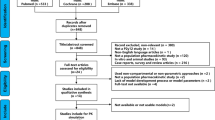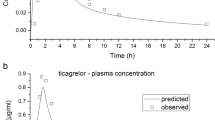Abstract
Purpose
CTB-001, a recently developed generic version of bivalirudin, an FDA-approved anticoagulant used for prophylaxis and treatment of cardiovascular diseases, has shown good efficacy and safety in clinical trials. We characterized the pharmacokinetics (PK) and pharmacodynamics (PD) of CTB-001 by modeling and simulation analysis.
Methods
PK/PD data were collected from a randomized, double-blind, placebo-controlled, single-dose, dose-escalation phase 1 study conducted in 24 healthy Korean male subjects. PK/PD analysis was conducted sequentially by nonlinear mixed-effects modeling implemented in NONMEM®. Monte-Carlo simulations were conducted for PK, activated partial thromboplastin time (aPTT), prothrombin time (PT), and thrombin time (TT).
Results
The CTB-101 PK was best described by a three-compartment linear model with a saturable binding peripheral compartment. All PD endpoints showed dose-response relationship, and their changes over time paralleled those of CTB-101 concentrations. A simple maximum effect model best described the aPTT, PT in INR, PT in seconds, and TT, whereas an inhibitory simple maximum effect model best described PT in percentages. The maximum duration of effect of CTB-001 on aPTT prolongation was 52.1 s.
Conclusions
The modeling and simulation analysis well-characterized the PK and PD of CTB-001 in healthy Koreans, which will be valuable for identifying optimal dosing regimens of CBT-001.




Similar content being viewed by others
Abbreviations
- ACT:
-
Activated clotting time
- aPTT:
-
Activated partial thromboplastin time
- BCmax :
-
Maximum binding capacity
- CWRES:
-
Conditional weighted residual
- EC50 :
-
Half-maximal effective concentration
- Emax :
-
Maximum effect
- IC50 :
-
Half-maximal inhibitory concentration
- INR:
-
International normalization ratio
- Kassoc :
-
Association rate constant
- Kdissoc :
-
Dissociation rate constant
- PD:
-
Pharmacodynamic
- PK:
-
Pharmacokinetic
- PT:
-
Prothrombin time
- TT:
-
Thrombin time
References
Libby P. Mechanisms of acute coronary syndromes and their implications for therapy. N Engl J Med. 2013;368(21):2004–13.
Eikelboom JW, Mehta SR, Anand SS, Xie C, Fox KAA, Yusuf S. Adverse impact of bleeding on prognosis in patients with acute coronary syndromes. Circulation. 2006;114(8):774–82.
Verheugt FWA, Steinhubl SR, Hamon M, Darius H, Steg PG, Valgimigli M, et al. Incidence, prognostic impact, and influence of antithrombotic therapy on access and nonaccess site bleeding in percutaneous coronary intervention. JACC Cardiovasc Interv. 2011;4(2):191–7.
Di Nisio M, Middeldorp S, Büller HR. Direct thrombin inhibitors. N Engl J Med. 2005;353(10):1028–40.
Warkentin TE, Greinacher A, Koster A. Bivalirudin. Thromb Haemost. 2008;99(5):830–9.
Hirsh J, Warkentin TE, Raschke R, Granger C, Ohman EM, Dalen JE. Heparin and low-molecular-weight heparin: mechanisms of action, pharmacokinetics, dosing considerations, monitoring, efficacy, and safety. Chest. 1998;114(5 Suppl):489S–510S.
Allie DE, Lirtzman MD, Wyatt CH, Keller VA, Khan MH, Khan MA, et al. Bivalirudin as a foundation anticoagulant in peripheral vascular disease: a safe and feasible alternative for renal and iliac interventions. J Invasive Cardiol. 2003;15(6):334–42.
Buck ML. Bivalirudin as an Alternative to Heparin for Anticoagulation in Infants and Children. J Pediatr Pharmacol Ther. 2015;20(6):408–17. https://doi.org/10.5863/1551-6776-20.6.408.
Edrich T, Frendl G, Rawn JD, Paschalidis Y. Modeling the effects of bivalirudin in cardiac surgical patients. Conf Proc IEEE Eng Med Biol Soc. 2011;2011:120–3.
Chai D, Wang R, Bai N, Cai Y, Liang B. Development and validation of a LC-MS/MS method for determination of bivalirudin in human plasma: application to a clinical pharmacokinetic study. Biomed Chromatogr. 2013;27(12):1788–93.
Capodanno D, Gargiulo G, Capranzano P, Mehran R, Tamburino C, Stone GW. Bivalirudin versus heparin with or without glycoprotein IIb/IIIa inhibitors in patients with STEMI undergoing primary PCI: an updated meta-analysis of 10,350 patients from five randomized clinical trials. Eur Heart J Acute Cardiovasc Care. 2016;5(3):253–62.
Fox I, Dawson A, Loynds P, Eisner J, Findlen K, Levin E, et al. Anticoagulant activity of Hirulog, a direct thrombin inhibitor, in humans. Thromb Haemost. 1993;69(2):157–63.
Robson R. The use of bivalirudin in patients with renal impairment. J Invasive Cardiol. 2000;12(Suppl F):33F–6.
Shammas NW. Bivalirudin: pharmacology and clinical applications. Cardiovasc Drug Rev. 2005;23(4):345–60.
Robson R, White H, Aylward P, Frampton C. Bivalirudin pharmacokinetics and pharmacodynamics: effect of renal function, dose, and gender. Clin Pharmacol Ther. 2002;71(6):433–9.
Acknowledgments
This research was supported by C-TRI Co., Ltd. (Gyeonggi-do, Republic of Korea), the manufacturer of CTB-001. W.J.K. was an employee of C-TRI Co., Ltd. at the time of the study. There are no other relationships or activities that could have influenced the results and interpretation of the submitted work.
Author information
Authors and Affiliations
Corresponding author
Additional information
Publisher’s Note
Springer Nature remains neutral with regard to jurisdictional claims in published maps and institutional affiliations.
Rights and permissions
About this article
Cite this article
Han, S., Kim, YH., Choi, H.Y. et al. Pharmacokinetic and Pharmacodynamic Modeling and Simulation Analysis of CTB-001, a Recently Developed Generic of Bivalirudin. Pharm Res 36, 146 (2019). https://doi.org/10.1007/s11095-019-2676-6
Received:
Accepted:
Published:
DOI: https://doi.org/10.1007/s11095-019-2676-6




